Panda Security 2017 Review
Panda's antivirus products have an appealing interface, but they suffer from heavy system impact and middling malware protection.

From a free virus scanner to the company's top-of-the-line Gold Protection package, Panda Security provides satisfactory protection along with a slew of extras for which competitors often charge more. Panda's Antivirus Pro program is one of the most complete basic security packages we've seen, and comes with a virtual keyboard, two-way firewall and Wi-Fi network scanner.
Yet while all the Panda products present an appealing, customizable interface, and the mid-range and premium suites add many useful features, their shared malware-detection engine delivers a heavy system-performance impact.
The higher-tier suites are pricey compared with rival brands, and even the most expensive Panda suite tried to change our default web browser's home page and search engine, something we'd previously seen only with free software. They don't quite make the list of the best antivirus software.
Costs and What's Covered
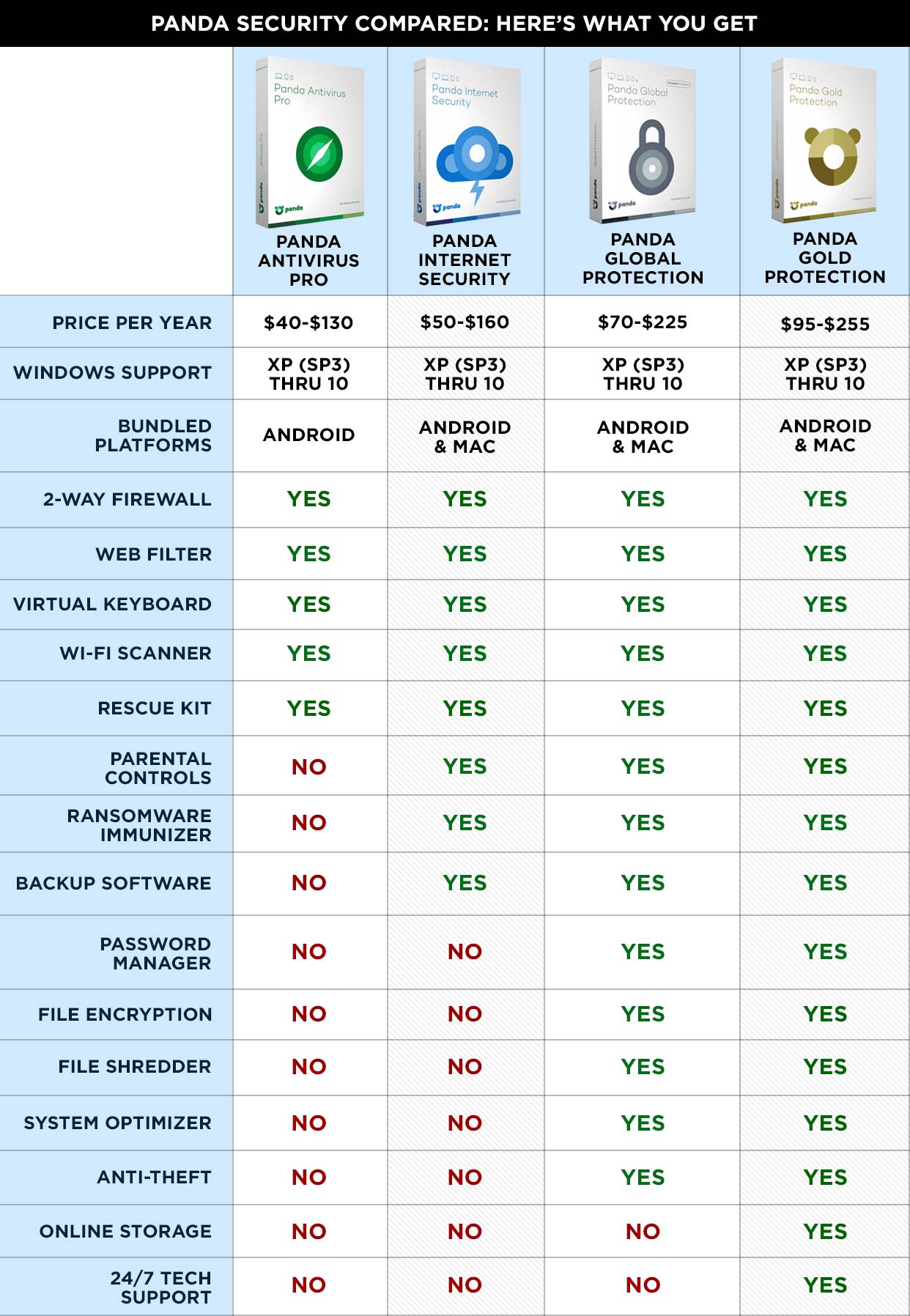
Panda Free Antivirus provides the most basic protection at no cost. This can be augmented with the Antivirus Pro version, starting at $40 for one PC for one year. (It's $60 for three PCs, and $80 for five.)
Antivirus Pro includes competent malware protection and safe web browsing, as well as an Android antivirus program, a battery-life optimizer and extensions for an Android Smartwatch. Users of Android and iOS systems also can tag a stolen or lost device on a map.
The next step up is to Internet Security, which covers a single computer for one year for $50, three computers for $75 or five for $100. It adds parental controls, backup software and the company's Data Shield to protect files from ransomware.
Internet Security also includes a single license for Panda's Mac antivirus software, normally $70 per year, but only if you buy Internet Security for multiple PCs. The Mac software can also perform malware scans on attached iPhones or iPads.
Sign up to get the BEST of Tom's Guide direct to your inbox.
Get instant access to breaking news, the hottest reviews, great deals and helpful tips.
(We've not evaluated Panda's software for other platforms, so we can't tell you if Panda's products are among the best Mac antivirus software or the best Android antivirus apps.)
The nearly-top-of-the-line Global Protection package adds a password manager, file encryption and a file shredder, as well as a performance optimizer. It starts at $70 for a single computer for one year. (Three computers are $105, and five are $140.)
Panda Gold Protection, the package that we directly evaluated, is mostly identical to Panda Global Protection, but adds 24/7 tech support and 20GB of online storage space. It can cover a single computer for $95 for one year, or up to 10 computers for $255 per year.
Panda's prices ramp up rather quickly the more devices you add (although discounts can often be found online). Antivirus Pro is $60 for three PCs per year, which matches most competitors. But it's $80 for five PCs, $105 for 10 and $130 for an unlimited number.
By comparison, Bitdefender Antivirus Pro is $80 for 10 PCs, and its top-of-the-line Bitdefender Family Pack is $120 for unlimited devices. McAfee's mid-range Internet Security package is $80 per year and can also be installed on an unlimited number of devices.
Panda's products support Windows XP with Service Pack 3 through Windows 10. The Mac software supports OS X 10.6 or newer. Panda's Android apps require Android 4.0 Ice Cream Sandwich or later, and its iOS software (really just a device locator) requires at least iOS 7.0.
Antivirus Protection
Panda's malware protection is the same for all its Windows antivirus products. The protection starts with traditional viral-signature matching, which compares new files against a large database of known malware using the company's home-grown scanning engine. This is backed up by "heuristic" monitoring, which catches new "zero-day" and shape-shifting malware by analyzing its behavior, code and other characteristics.
Panda's 30 million customers feed suspect malware to Panda's cloud-based Collective Intelligence system for analysis. Unlike many antivirus companies, Panda won't let you opt out of this sample-collection system if you have privacy concerns. Malware signatures are updated several times a day.
You can manually initiate a full scan of the entire system, a Critical Scan of key areas and files, or scans of individual files or folders. You can schedule full or critical scans to run daily, weekly or monthly.
MORE: Best Antivirus Protection for PC, Mac and Android
If a USB drive is inserted, Panda alerts you and scans the drive's contents. You can also "vaccinate" thumb drives so that executable files won't automatically run upon connection.
Antivirus Performance
Panda's malware-protection software caught most of the attacks thrown at it in evaluations conducted by German independent testing lab AV-TEST, but missed a few threats and delivered several false positives.
AV-TEST's most recent survey of antivirus software brands on Windows 10 showed that in March 2016, Panda Free Antivirus stopped 100 percent of widespread, known malware and 99.9 percent of new zero-day malware. In April, those figures were 99.8 percent and 99.9 percent, respectively.
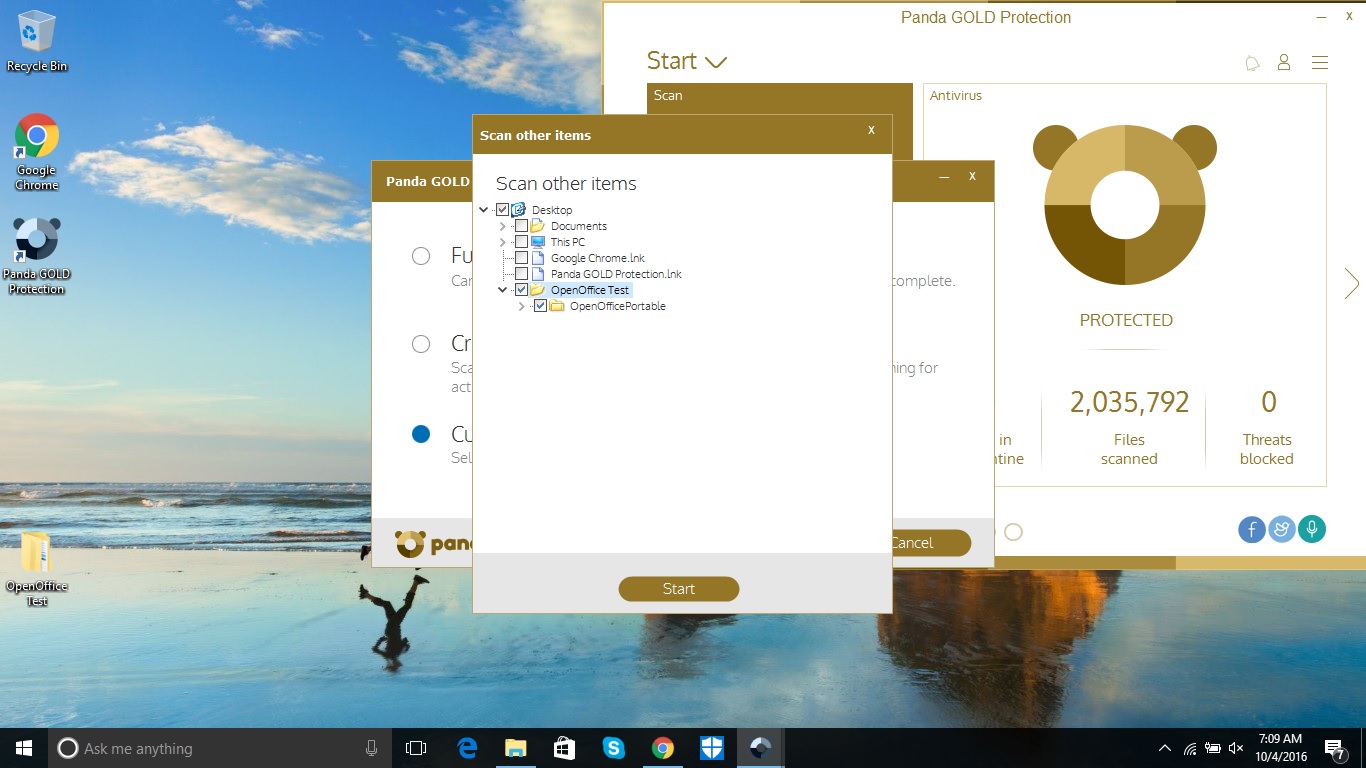
In the Windows 10 tests, Panda Free Antivirus returned two false positives in each month, less than the industry average of three. By comparison, Kaspersky Internet Security had perfect scores against both categories of malware in each month, with no false positives.
In AV-TEST's most recent Windows 8.1 runs, Panda's detection rates fell to 97.8 percent of widespread malware and 99.7 percent of zero-day malware in May 2016, and 98.6 percent of known malware and 99.8 percent of brand-new malware in June. Panda Free Antivirus had one false positive each month, much better than the industry average of six and better than Bitdefender Internet Security's four false positives each month.
Panda's false-positive rate returned to the mean in AV-TEST's Windows 7 evaluations in July and August 2016. Panda Free Antivirus notched up five in the first month and seven in the second, matching the industry average of six per month.
MORE: Best Mobile Password Managers
The software caught 99.8 percent of zero-day malware in July, and 96.2 percent in August; it caught 99.8 percent of widespread malware in each month. In contrast, Bitdefender Internet Security caught all the malware in each month, but registered three false positives in July. (We often include evaluations conducted by an Austrian lab, AV-Comparatives, but Panda did not participate in that lab's most recent tests.)
Security and Privacy Features
Each paid Panda product covers the basics well, with malware and anti-phishing defenses, but treats spam as just another assault. Panda Antivirus Pro is pretty well-stocked with extra features for a basic product: It comes with a virtual keyboard to stop keylogging malware from collecting your passwords, as well as a license for Panda's Android antivirus app.
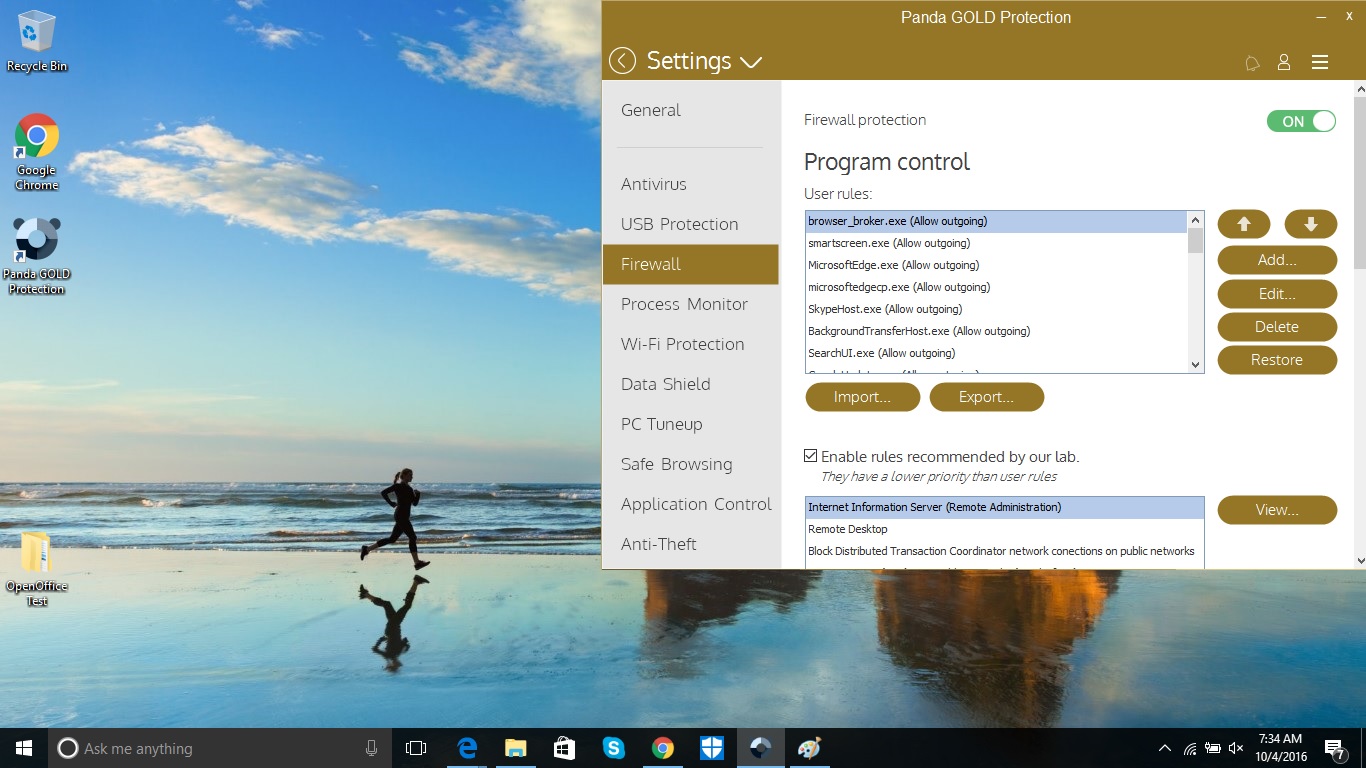
There's also a two-way firewall to take over from the Windows one, a Wi-Fi scanner to look for network insecurities and display all connected devices, and browser extensions to keep your identity secure by checking the reputation of sites before you arrive. None of the Panda products offer a hardened browser for online shopping or banking.
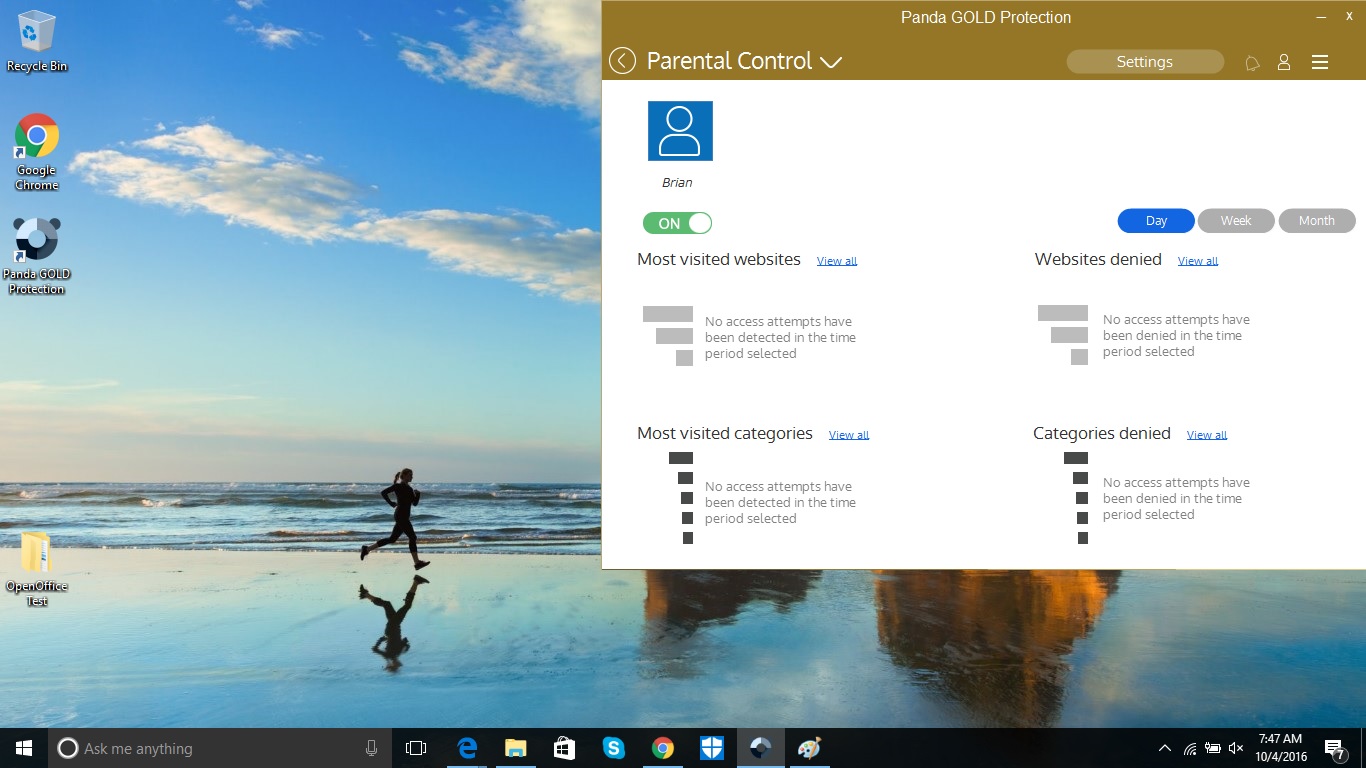
The Internet Security package adds strong parental controls that can prevent children from being exposed to objectionable themes, ranging from alcohol use to the merely tasteless. I liked that you can see where your children have surfed and what's been blocked. There's a Data Shield to prevent must-keep files (such as photos and tax records) from being encrypted by a ransomware attack, and backup software for rebuilding a broken or infected system. (You'll need to save the archives locally.)
Panda's Global Protection suite adds several useful, if nonessential, tools. A password manager works with both third-party applications and websites; a file shredder and a separate file encryptor safeguard or destroy anything that should never see the light of day; a system optimizer eliminates duplicate, temporary and old files; and an anti-theft system will track your lost or stolen PC on a map – as long as the PC is still turned on.
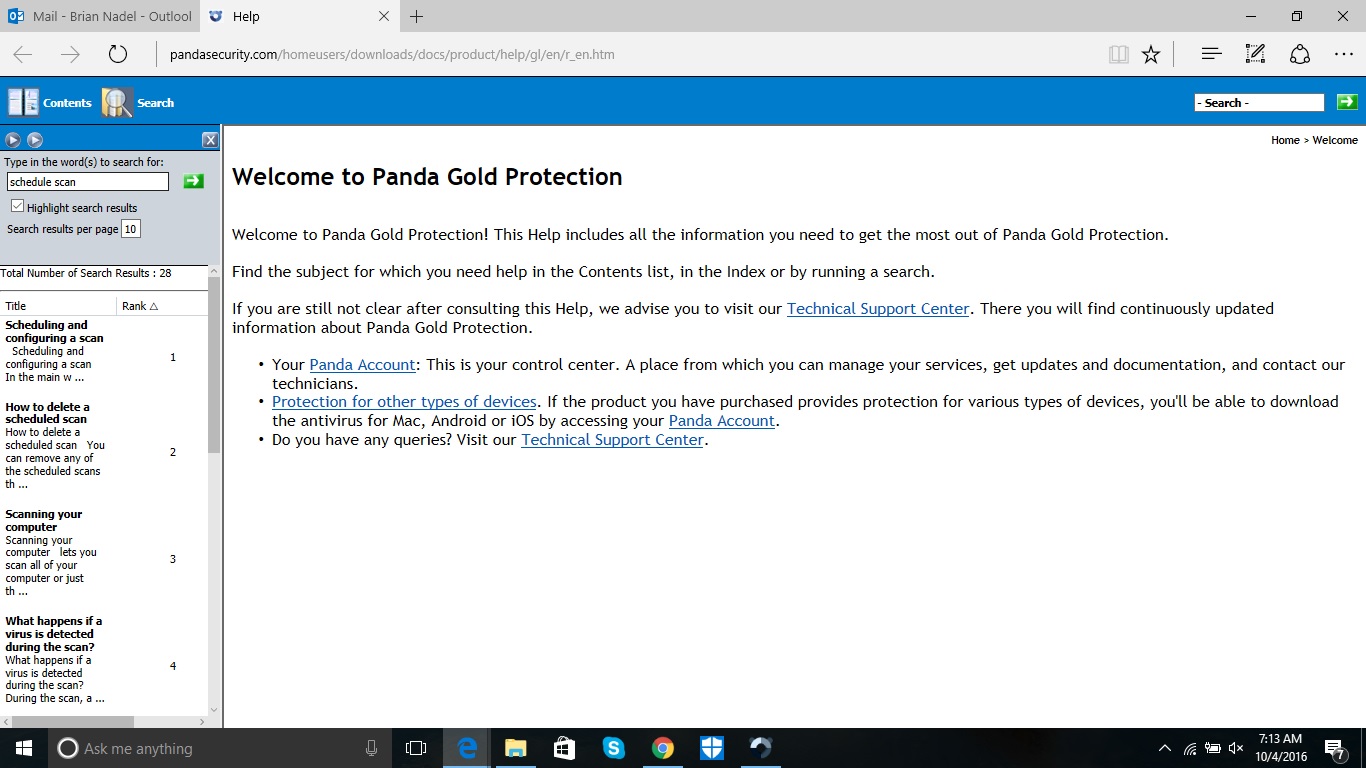
Panda Gold Protection is basically Global Protection, except with backups for your contacts on any device, as well as 20GB of online storage space. It also offers Panda's "premium" tech support, which includes 24/7 access to technicians via chat or remote access, weekend telephone support and basic assistance with any issue regarding your computers and smartphones. Users of the less expensive products have to make do with emailed queries and telephone technicians available only during East Coast business hours.
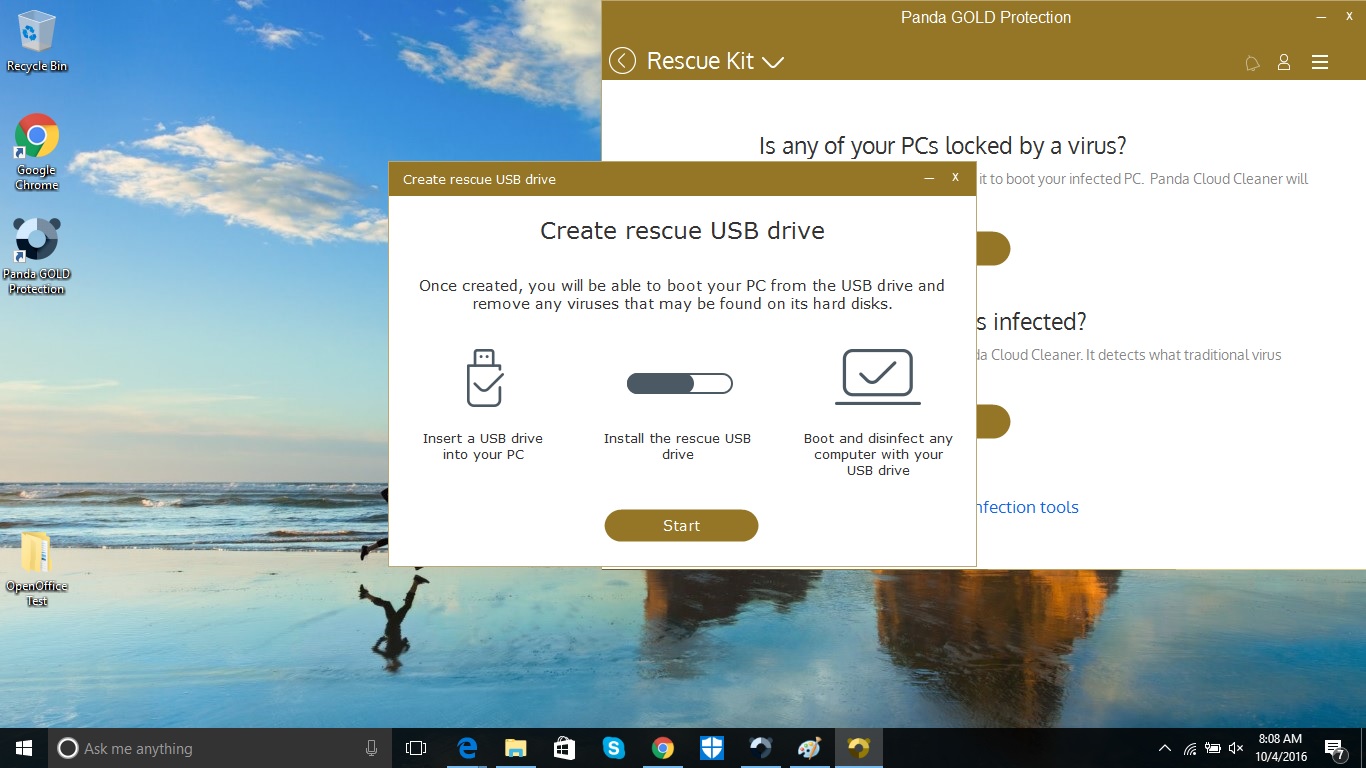
While most antivirus companies require you to download software and burn it to a CD to create a rescue disk, Panda's Rescue Kit is built into all its paid products. It lets you either create a startup USB thumb drive (sorry, no CDs or DVDs) or open up a separate application that uses the Panda Cloud Cleaner to scan and disinfect your computer directly from the internet.
Performance and System Impact
Panda Gold Protection not only slowed down our test computer significantly, but also scanned our hard drive more slowly than other antivirus products. (There's often a trade-off between system-performance impact and scanning speed.) The test machine was an ASUS X555LA notebook with a 2-GHz Intel Core i3 processor, 6GB of RAM and a 500GB hard drive, 36GB of which was filled. The system ran Windows 10 with the latest updates.
Performance was assessed by the completion time of our OpenOffice-based stress test, which matches 20,000 names and addresses in a spreadsheet. We ran the test in four scenarios: with no antivirus software installed; after the Panda software was installed; during full scans; and during "critical" scans.
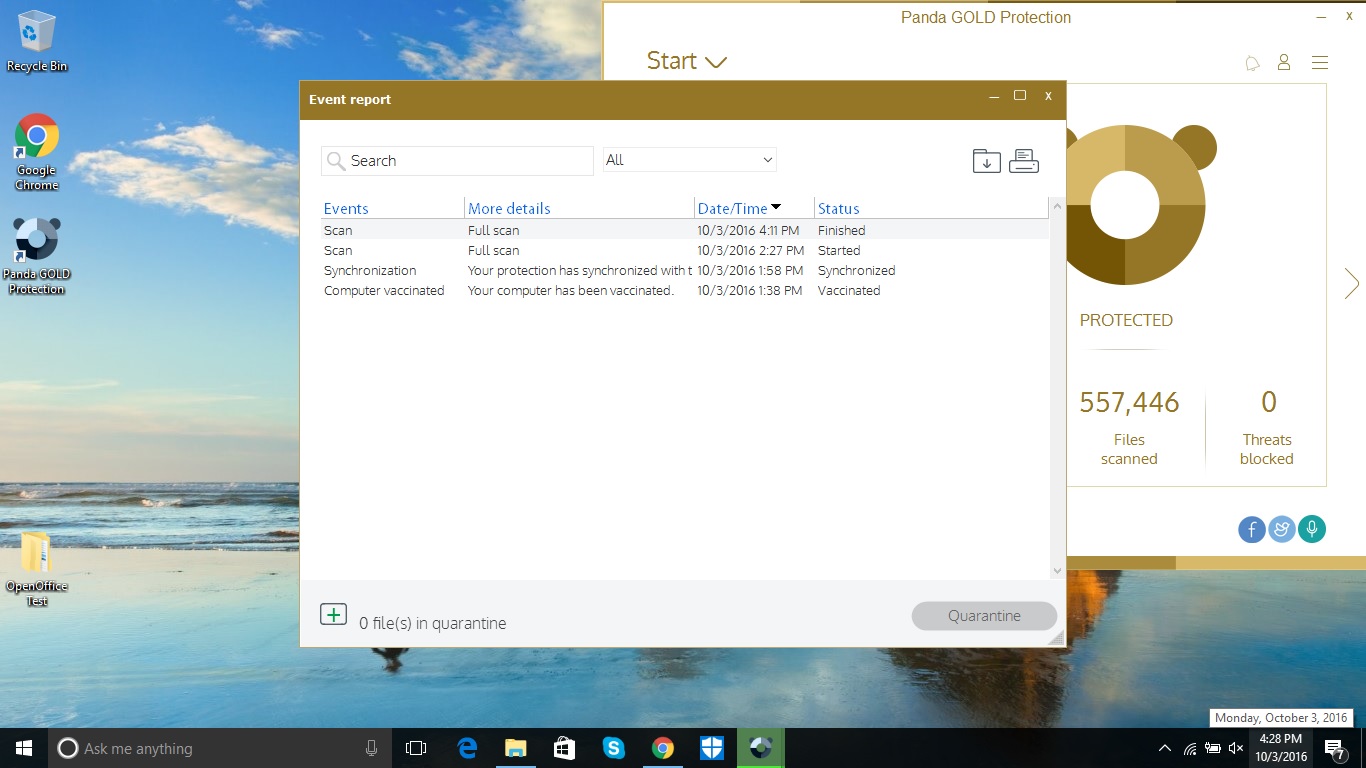
We established a baseline by running the OpenOffice test with no malware software installed, but with Microsoft's Windows Defender running by default. The test completed its tasks in 7 minutes and 1 second. After Panda Gold Protection was installed, the same routine took 7 minutes and 25 seconds, indicating a moderate passive slowdown of 5.7 percent. We've seen worse, but a rival product, Kaspersky Total Security, had zero impact.
During a full scan, the OpenOffice test took 10 minutes and 2 seconds, a 43 percent slowdown compared to the baseline. That's fairly heavy — Bitdefender Total Security notched up an 18 percent hit. A Critical Scan — Panda's approximation of a quick scan — resulted in an Open-Office result of 9:10, a 31 percent performance hit comparable to that of Trend Micro Maximum Security, but much more than Kaspersky Total Security's 5.5 percent quick-scan impact.
It took 1 hour and 44 minutes for Panda Gold Protection to perform its initial full scan of all 471,545 files on our hard drive. Because the first scan often takes the longest, we ran it several more times, after which it settled down to about 54 minutes each time, putting it on a par with Bitdefender's leisurely 51 minutes.
Trend Micro and Kaspersky each scanned the same drive in less than 5 minutes, but at a cost: Each had much higher system impacts than Bitdefender. Panda, unfortunately, seemed to have the worst of both worlds, with both high system-performance impacts and long full-scan times.
Panda's Critical Scan looks for the most pressing attacks, and it took an average of 2 minutes and 56 second to examine 27,431 files. That's slow compared with the quick scans of rival brands, such as Bitdefender (8.9 seconds) or Kaspersky (1 minute and 51 seconds), yet Panda's was more taxing in terms of performance.
MORE: Best VPN Services for Staying Anonymous Online
Interface
Panda's interface hasn't changed since last year. Dominated by a stylized panda-head silhouette, the main window lacks the checkmark that dominates security software today. Instead, the program displays "Protected."
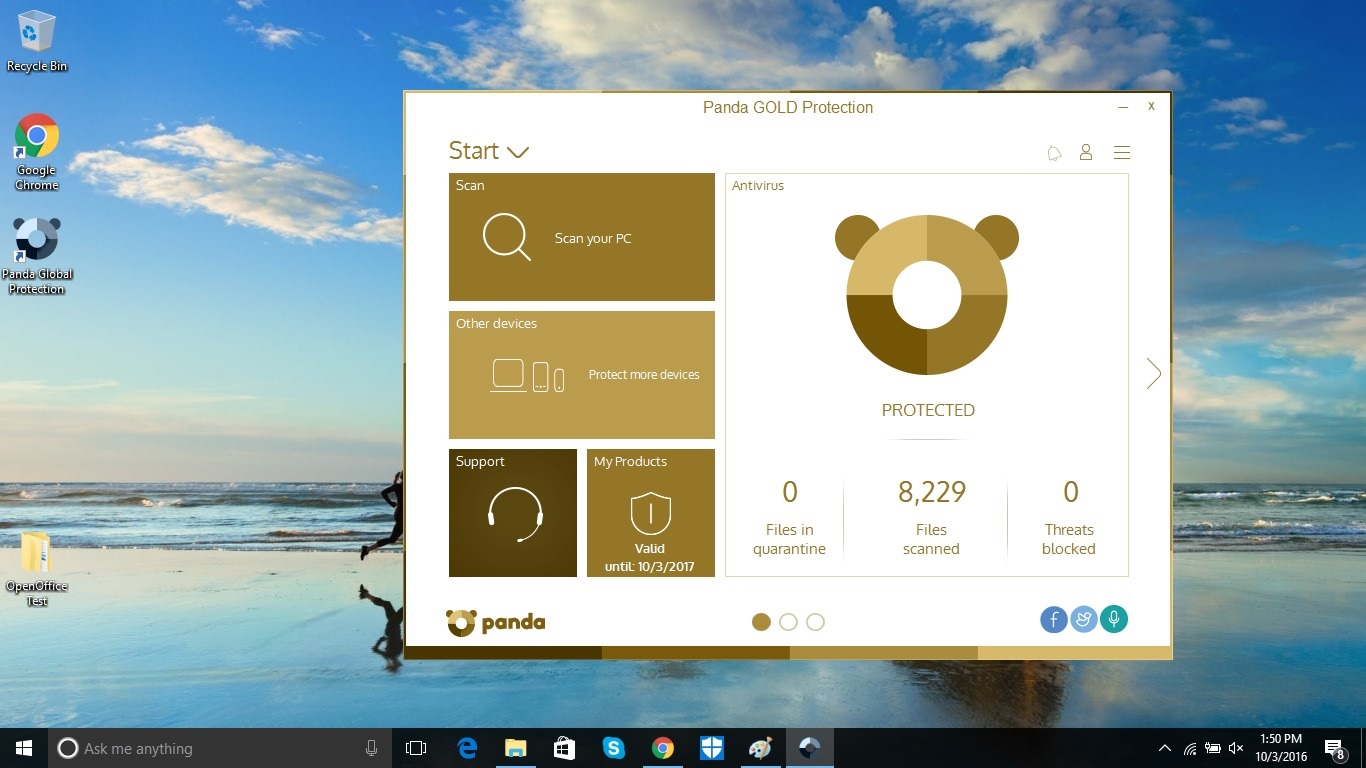
The main window's default has a scan button that lets you start a critical or full scan in two clicks. Below that button is a box to add coverage to more devices, followed by a Support button and a display that shows when the subscription expires.
Unlike other security software, Panda lets you customize its interface by moving items among its three pages of features. Want Parental Controls in your face? Drag it to the front page. However, the interface has two box sizes that aren't interchangeable.
With Panda's regular tech support, technicians are available Monday through Friday from 9 a.m. to 5 p.m. Eastern time for toll-free telephone and email help. This doesn't measure up to Bitdefender's 24/7 telephone support; the Premium tech support that comes with Gold Protection lets you speak to technicians on evenings and weekends, but not in the wee hours of the morning.
Setup and Installation
Loading Panda's consumer products onto a PC starts with a 1.8MB installer program, which does a compatibility and malware check. After you input the activation code, the rest of the program downloads, updates and installs.
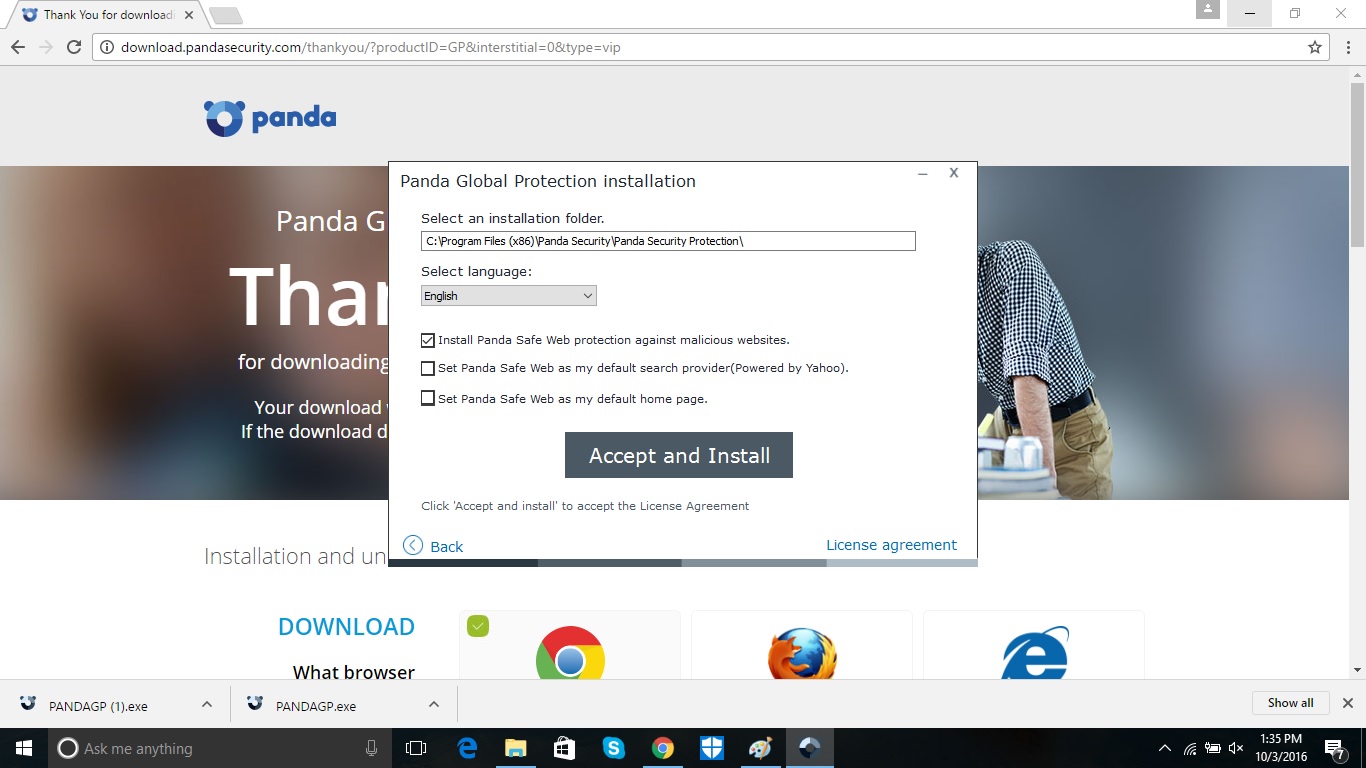
At the end of the process, you'll need set up an online account, but be warned: Panda wants to change your default web browser's search engine and homepage to Yahoo and Panda, respectively. You'll need to find and unclick two pre-checked permissions boxes during the installation process to maintain your online status quo. (We've seen this somewhat underhanded behavior with some free antivirus programs, but never with a paid one until now.)
Like many other antivirus installers, Panda's sets you up for auto-renewal on your credit card when the subscription expires. You can avoid this by digging into the program's settings.
Bottom Line
Panda's antivirus products provide reasonable protection against the worst that the internet can throw at a Windows PC, but they are slow to scan, put a burden on the system and want to take over your search engine and homepage.
The benefits of each Panda paid product vary. The basic Antivirus Plus program does quite a lot for a little, and is a good choice for fully protecting one or two computers, although Bitdefender Antivirus Plus has better malware protection and a smaller system impact.
But as you rise through the company's Internet Security, Global Protection and Gold Protection suites, the prices rise quickly, and there's no unlimited plan for the top-level Gold product. Panda falls short of the mark for large digital families looking for lots of protection at a reasonable price — for those, we recommend Bitdefender Total Security Multi-Device or Kaspersky Total Security.
Brian Nadel is a freelance writer and editor who specializes in technology reporting and reviewing. He works out of the suburban New York City area and has covered topics from nuclear power plants and Wi-Fi routers to cars and tablets. The former editor-in-chief of Mobile Computing and Communications, Nadel is the recipient of the TransPacific Writing Award.

